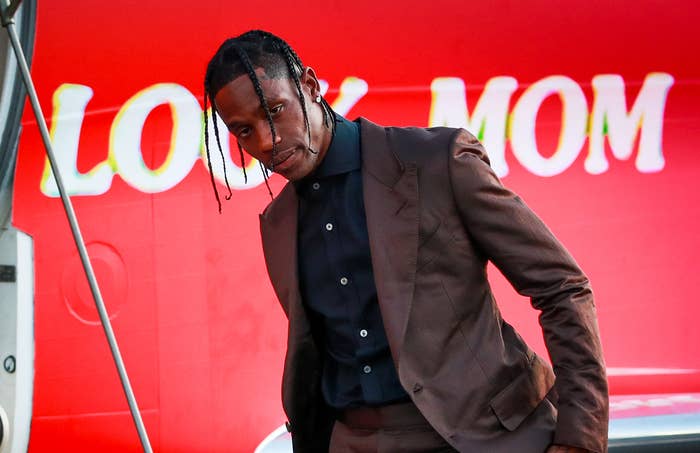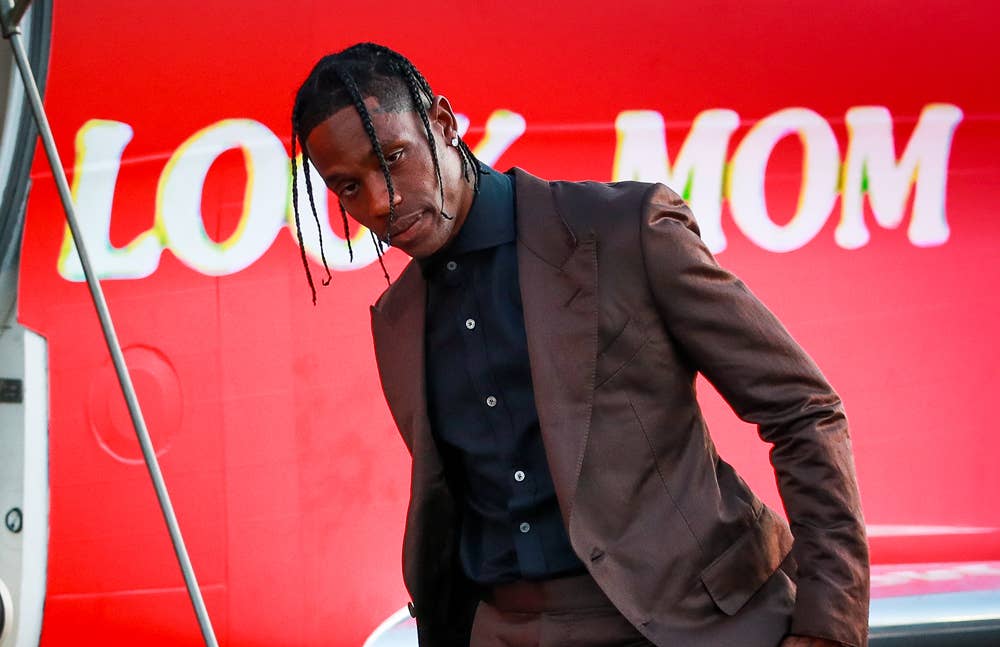
The best scene in Travis Scott’s Netflix documentary Look Mom I Can Fly is, on the surface at least, one of the least intimate.
Throughout the 85-minute runtime of the film, we see Travis interacting with his grandmother in his childhood bedroom, witnessing the birth of his first child, hugging his family after performing at the Super Bowl halftime show, and reacting to going 0 for 3 on his first Grammy nominations in real-time. But the most thrilling scene finds Travis and his team hunkered down in a sun-drenched Hawaii compound, working tirelessly to bring his watershed album to the finish line. He has just completed work on the raucous “No Bystanders,” and just as soon as it’s finished, he’s blasting it on replay, with his boys going wild almost in choreographed unison—an electric sequence heralding the birth of an electric track.
For artists who practice reclusivity and a kind of composed mysteriousness the way Travis Scott does, a “behind-the-scenes” documentary is always going to be an event worth tuning into. To be clear, he isn’t quite as difficult to find these days, as he reaches the crest of his superstardom. When he isn’t embarking on a tour that spawns new social media clips with every stop, there are internet-breaking shoe drops to fill the space, as well as nationally televised performances. And you’d be hard-pressed to find a major rap release in the past year that didn’t boast a guest feature from him. Also, his girlfriend and the mother of his child is one of the most famous people on the planet. Still, by this decade’s standards, Travis doesn’t share much of himself in the ways that his peers typically do. He isn’t much of a tweeter, and when he does post to Instagram, it’s obscure pictures and captions with stories that are far from “produced” or staged or give any sense of what he’s actually doing at the moment. Which is fine and totally his prerogative! But as such, it makes something like Look Mom I Can Fly automatically compelling.
moments of intense craftsmanship are countered by scenes displaying unbridled excitement, both for his own work and the way it intersects with others.
Seeing glimpses into Travis’ home life, nuclear family with Kylie and Stormi, upbringing, interactions with his team (and with Kanye), winning nominations, losing awards—all of that shit is novel. This is the same guy who, for the longest time (and sometimes still does) posed with his face carefully angled away from the camera. But when the Netflix doc truly comes alive, it’s in the all-too fleeting glimpses of Travis creating music.
We see such a moment early on. Travis has just touched down, having been arrested for allegedly inciting riots at his show the night before. On the ride from the airport, he puts Murda Beatz’ instrumental for what would become “Butterfly Effect” on loop, seemingly disappointed that it can’t go louder, but nonetheless entranced, mumbling unintelligible words around a refrain of “for this life I cannot change.” Even without an explicit throughline, placing his arrest before this scene immediately lends the line from a two-year-old song a new context. Many scenes and one year later, on the eve of ASTROWORLD’s release, he has a similarly hypnotic focus listening back to the album intro, obsessively noting that every detail in the mix is perfect and passes the Car Test. These moments of intense craftsmanship are countered by scenes displaying unbridled excitement, both for his own work and the way it intersects with others: marveling at Drake’s verse on “Sicko Mode,” Kevin Parker’s work on “Skeletons,” James Blake’s vocals for “Stop Trying to be God,” or going bar-for-bar on new signee Don Toliver’s music as he prepares to pay it forward.
Travis also gets his Beyoncé moment, passionately dressing down the Astroworld tour crew for his perceived shortcomings in the production. He dwells on granular details about the lighting and camera angles that would seem imperceptible to anyone else, especially the fans. “The roller coaster needs to be lit!” he yells. “You're still not lighting the base. If I can't see those from where I'm at, nobody can see them. These lights along the rail of the roller coaster, I don't get no action.” (If it was indeed Garden Night 1, he should know the show went off without a hitch to us.) It’s Travis as you’ve never seen him, riled up, assertive and authoritative, kind of mean, incidentally funny (he ends the rant by walking off with a dismissive: “Other than that it was great”). But as anyone who attended the tour can attest, it’s not “surprising,” given how much of an experiential, detail-oriented show he puts on.
Look Mom I Can Fly has its flaws, and it’s far from a perfect documentary, but it excels when it gives us a rare look at Travis Scott’ creative process. There are many interesting facets of his life, but I’d be happy with an hour-plus doc that just captures him at work.

